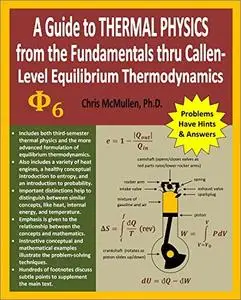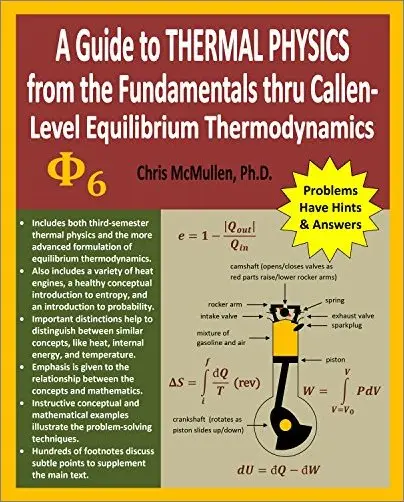A Guide to Thermal Physics: from the Fundamentals thru Callen-Level Equilibrium Thermodynamics by Chris McMullen
English | August 26, 2010 | ISBN: 1453772804 | PDF | 320 pages | 4 MB
English | August 26, 2010 | ISBN: 1453772804 | PDF | 320 pages | 4 MB
AUDIENCE: This thermodynamics textbook is suitable for all students of thermal physics, from the third semester of introductory calculus-based physics thru more advanced coursework in thermodynamics. It provides much greater depth than the coverage of thermal physics in traditional calculus-based physics textbooks, and in this way may be useful to students who are just learning thermal physics. It also provides a solid foundation in the fundamentals and covers both introductory thermal physics (thermal expansion, heat conduction, thermal radiation, ideal gases, and heat engines) and the mathematical formulation of thermodynamics (fundamental relation, Euler and Gibbs-Duhem, thermodynamic potentials, thermodynamic systems, Maxwell relations, and phase transitions) in a more unified way; and in this way may be very helpful to students who are studying undergraduate or graduate level thermodynamics. This textbook also serves as a useful review of thermal physics and thermodynamics for students who have already studied thermodynamics.
CONTENT: The beginning chapters are largely geared toward providing a solid foundation of the fundamental concepts and their relationship with the mathematics. The material from these chapters is intended to serve as a valuable introduction for beginning students and self-learners, and also as a useful review for advanced students. The later chapters grow increasingly in-depth: For example, the treatise of heat conduction discusses the integral in a variety of forms and even compares it to more familiar electrical concepts; the chapter on heat engines derives the Carnot efficiency in general using the entropy change integral, and covers a variety of cycles, including the endoreversible engine; and thermodynamics includes not only the usual thermodynamic square, but also the more general octahedron and cross polytope.
PREREQUISITES: No previous exposure to thermal physics is assumed. The student should be familiar with the techniques of calculus; a brief review of some relevant techniques, such as partial differentiation, is included.
MATHEMATICAL & CONCEPTUAL EMPHASIS: There is much emphasis both on learning the mathematics precisely and understanding the concepts at a deep, precise level. An underlying idea is that students should not guess at concepts, but that concepts are mathematically motivated: Let the equations be your guide.
EXAMPLES: Each chapter includes fully-solved examples to illustrate the main problem-solving strategies.
PRACTICE: The end of each chapter has a good selection of instructive conceptual questions and practice problems.
HINTS & ANSWERS: 100% of the conceptual questions have both hints and answers, since it's crucial to develop a solid understanding of the concepts in order to succeed in physics. Some of the practice problems have answers to help independent students gain confidence by reproducing the same answers, while 100% of the practice problems have hints so that students can see if they are solving the problems correctly.



